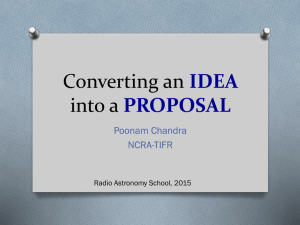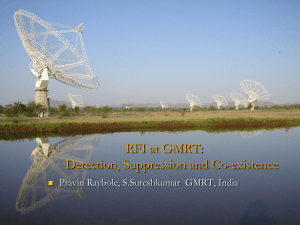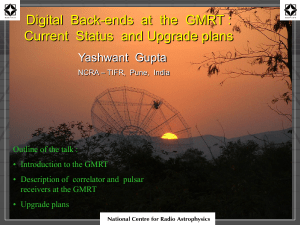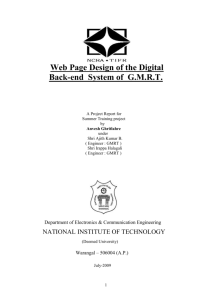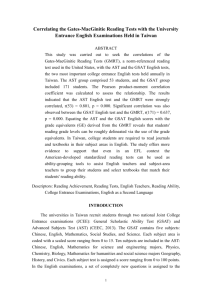G GMR RT VIS
advertisement
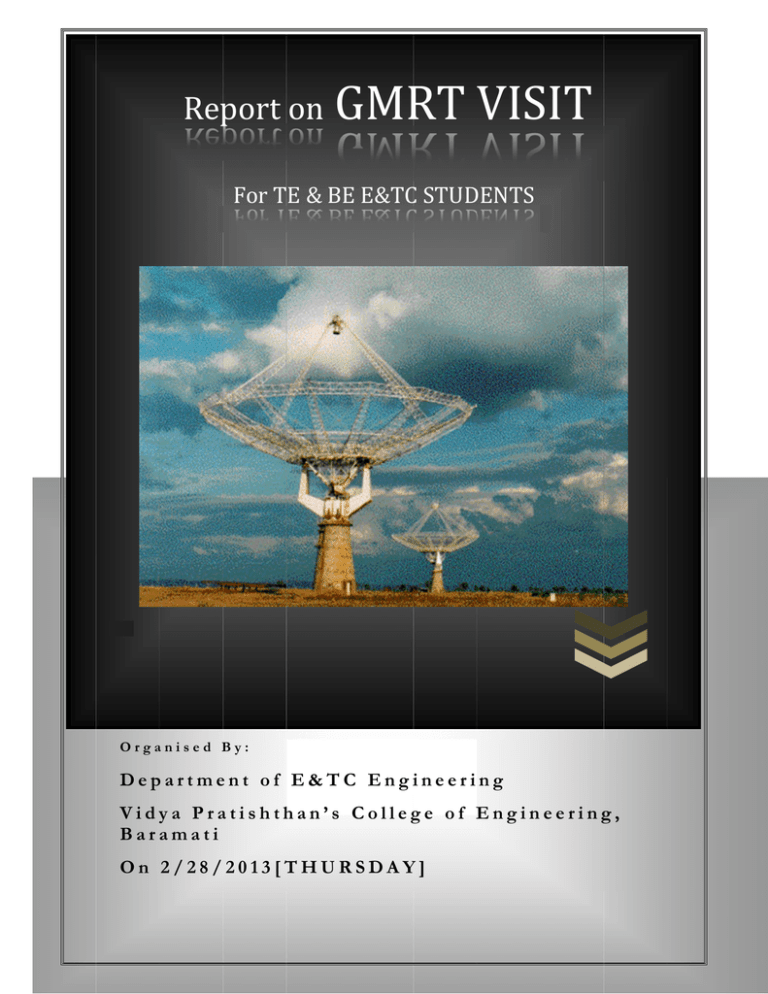
Rep portonG GMR RTVISSIT ForTE&BE EE&TC CSTUD DENTS Organised By: Department of E&TC Engineering Vidya Pratishthan’s College of Engineering, Baramati On 2/28/2013[THURSDAY] GMRT T-VISIT RE EPORT 1 Organized B By: Departtment of E&TC E Engin neering VPCOE E, BARAMA ATI GMRT-VISIT REPORT 2 Organized By: Department of E&TC Engineering OBJECTIVES The main objective of this visit is, as a part of Electronics and Telecommunication Engineering curriculum, the students need to know practical fundamentals, implementation, functionality, and mechanism of antennas. To get the knowledge of the Radio Telescope, different components involved, hardware-software co-design, data analysis etc. VPCOE, BARAMATI GMRT-VISIT REPORT 3 Organized By: Department of E&TC Engineering Purpose of VISIT: On the occasion of Science Day the nearly 96 students and 7 teaching and non-teaching staff of VPCOE have visited GMRT on 28th Feb 2013. February 28th is celebrated as National Science Day all over the country, commemorating the discovery of the Raman Effect by C.V. Raman, for which he was awarded the Nobel Prize in Physics in 1930. Each year, Science Day is celebrated at the Giant Metrewave Radio Telescope (GMRT) observatory at Khodad. The GMRT, which is the world's most powerful telescope operating at low radio frequencies, was built and is being operated by the National Centre for Radio Astrophysics (NCRA) of the Tata Institute of Fundamental Research (TIFR). Although the prime activity at NCRA and GMRT is to carry out frontline research in radio astronomy and astrophysics, and develop state-of-the-art instrumentation for this purpose, NCRA and GMRT observatory also have programmes to popularise science and technology among the general public, especially the student community. The Science Day celebrations comprise a major component of our outreach programmes. Science Day events are usually spread over two days starting 28th of February, in order to cater to the tremendous response from the general public, especially the students from the schools and colleges in the rural and semi-urban areas and districts in the western Maharashtra, especially those near the GMRT observatory. It is perhaps one of the largest Science Day events in rural India, with about a hundred schools, colleges and institutions participating, and over 15000 people visiting the observatory during the twoday event. The programme consists of a grand Science Exhibition, where children from the schools and colleges exhibit their science projects, and prizes are given for the best entries in different age groups. In addition, there are exhibitions illustrating astronomical themes and concepts, exciting results obtained with the GMRT, various subsystems of GMRT and illustrative models. There are also exhibits and live demonstrations from various research institutes and science popularisation groups, as well as teaching institutions such as the University of Pune and various national laboratories. There are also programmes to interact with well-known scientists and engineers and film shows on astronomical topics of current interest. VPCOE, BARAMATI GMRT T-VISIT RE EPORT 4 O Organized B Departtment of E&TC By: E Engin neering Introdu ucing GM MRT An illu uminated GMRT G an ntenna at tw wilight NCRA has set up a unique faciliity for raddio astron nomical reesearch usiing the metrew wavelengthss range of the radio spectrum, known as the Giant Metrewavee Radio Telesco ope (GMRT T), it is locaated at a site about 800 km north h of Pune. GMRT G con nsists of 30 fullyy steerable gigantic g parabolic dish hes of 45m m diameter each e spreadd over distaances of upto 255 km. GM MRT is one of the mo ost challengging experiimental pro ogrammes in basic sciencees undertakeen by Indiaan scientistss and engin neers. Why metre m waveelengths: The T metre wavelengtth part of the t radio spectrum s h been has particullarly choseen for stuudy with GMRT G beccause man n-made raddio interferrence is consideerably loweer in this part of th he spectrum m in Indiaa. Although h there arre many outstan nding astrophysics pro oblems wh hich are beest studied at metre wavelength w hs, there has, so o far, been n no large facility anyywhere in the world d to exploiit this partt of the spectruum for astro ophysical reesearch. The siite : The siite for GM MRT, aboutt 10 km eaast of Naraayangaon to own on thee PuneNasik h highway, was w selected after an exxtensive seaarch in man ny parts off India, considering several importantt criteria such s as lo ow man-m made radio noise, avvailability of o good commuunication, vicinity off industriaal, educatio onal and other infrastructure and, a geograp phical latituude sufficieently north h of the geeomagneticc equator in n order to have a reasonaably quiet io onosphere and yet be able to observe a goo od part of the t southern n sky as well. Antenn na configu uration: Th he number and configguration off the dishess was optim mized to meet the princip pal astrophysical objeectives whiich requiree sensitivityy at high angular resolutiion as welll as abilityy to imagee radio em mission from m diffuse extended regions. Fourteeen of the th hirty dishess are located d more or lless random mly in a com mpact centrral array in a reggion of abo out 1 sq km m. The rem maining sixxteen dishees are spreaad out alon ng the 3 arms of an appro oximately `Y Y'-shaped configuratio c on over a much largeer region, with w the longestt interferom metric baselline of abouut 25 km. VPCOE E, BARAMA ATI GMRT-VISIT REPORT 5 Organized By: Department of E&TC Engineering The multiplication or correlation of radio signals from all the 435 possible pairs of antennas or interferometers over several hours will thus enable radio images of celestial objects to be synthesized with a resolution equivalent to that obtainable with a single gigantic dish 25 kilo metre in diameter! The array will operate in six frequency bands centred around 50, 153, 233, 325, 610 and 1420 MHz. All these feeds provide dual polarization outputs. In some configurations, dual-frequency observations are also possible. The highest angular resolution achievable will range from about 60 arcsec at the lowest frequencies to about 2 arcsec at 1.4 GHz. The design breakthrough: GMRT is an indigenous project. The construction of 30 large dishes at a relatively small cost has been possible due to an important technological breakthrough achieved by Indian Scientists and Engineers in the design of light-weight, low-cost dishes. The design is based on what is being called the `SMART' concept - for Stretch Mesh Attached to Rope Trusses. The dish has been made light-weight and of low solidity by replacing the conventional back-up structure by a series of rope trusses (made of thin stainless steel wire ropes) stretched between 16 parabolic frames made of tubular steel. The wire ropes are tensioned suitably to make a mosaic of plane facets approximating a parabolic surface. A light-weight thin wire mesh (made of 0.55 mm diameter stainless steel wire) with a grid size varying from 10 X 10 mm in the central part of the dish to 20 X 20 mm in the outer parts, stretched over the rope truss facets forms the reflecting surface of the dish. The low-solidity design cuts down the wind forces by a large factor and is particularly suited to Indian conditions where there is no snowfall in the plains. The overall wind forces and the resulting torques for a 45-m GMRT dish are similar to those for only a 22-m dish of conventional design, thus resulting in substantial savings in cost. The dish is connected to a `cradle' which is supported by two elevation bearings on a yoke placed on a 3.6 m diameter slewing-ring bearing secured on the top of a 15 metre high concrete tower. The weight of the disk is about 80 tonnes and the counter-weight is about 40 tonnes. The dishes have alt-azimuth mount. The salient parameters and specifications of each dish are summarized in the Table. GMRT Antenna Specifications The large size of the parabolic dishes implies that GMRT will have over three times the collecting area of the Very Large Array (VLA) in New Mexico, USA which consists of 27 antennas of 25 m diameter and is presently the world's largest aperture synthesis telescope operating at centimetre wavelengths. At 327 MHz, GMRT will be about 8 times more sensitive than VLA because of the larger collecting area, higher efficiency of the antennas and a substantially wider usable bandwidth because of the low level of manmade radio interference in India. VPCOE, BARAMATI GMRT-VISIT REPORT 6 Organized By: Department of E&TC Engineering Electronic Frontends and Backends : Apart from the novel low-cost design of the parabolic dishes, the instrument has state-of-the-art electronics systems developed indigenously and consisting of the following main sub units. Antenna feeds at six different frequency bands between 50 MHz and 1500 MHz, having good polarization characteristics as well as simultaneous multiband operation. Low-noise amplifiers, local oscillator synthesizers, mixers, IF amplifiers. Optical fibres linking the entire array with the CEB. These are used both for the telemetry signals and local oscillator phase reference communication between the CEB and each antenna base. A digital 2,30,000-channel FX-type correlator providing upto 128 spectral channels and covering a maximum bandwidth of 32 MHz VPCOE, BARAMATI GMRT T-VISIT RE EPORT 7 O Organized B Departtment of E&TC By: E Engin neering Goals o of GMRT Althouggh GMRT will be a very versattile instrum ment for invvestigating a variety of o radio astroph hysical pro oblems ran nging from m our nearrby Solar system to the edge of the observaable Univerrse, two of its most im mportant asstrophysicall objectivess are: To detect the highly redshifted spectral lin ne of neuttral Hydroggen expecteed from protoclusteers or proto ogalaxies before they condensedd to form galaxies g in tthe early phase of th he Universee and To search for and stuudy rapidly-rotating Puulsars in ouur galaxy. Epoch h of galaxyy formatio on: Theoriees of the formation f o structurre in the Big-Bang of B Universse predict the t presencce of proto o galaxies or o proto cluusters of gaalaxies madde up of clouds of neutral Hydrogen gas beforee their gravvitational condensatio c on into galaaxies. It should in principlle be possib ble to detecct these thrrough the well w known n radio line emitted by neuttral Hydroggen at a frrequency off 1420 MH Hz. The lin ne is howevver expecteed to be very weeak and reddshifted to metre wavelengths beecause of th he expansio on of the Universe U between emission n, billions off years ago,, and detection at the present epoch. For cllouds of Hydroggen betweeen redshiftss 3 and 10 (correspon nding to epochs when n the Univeerse had attainedd only a feew percent of its present age), the line sh hould be ob bservable b between frequen ncies of abo out 350 andd 130 MHzz. Detection n of such neutral n Hyddrogen clouuds is of fundam mental astro ophysical im mportance and can prrovide veryy importantt constraintts to the theories of formattion of galaaxies and clusters. Pulsarss and neutron stars:: GMRT sh hould also be an ideall instrumen nt for the study s of Pulsars (rapidly ro otating neutron stars with w extrem mely high densities d off about 2000 million tons peer cubic cm m). Its largge collectin ng area can n lead to a 3 to 4-fo old increasee in the numberr of Pulsarrs known in n our Galaaxy. A partiicularly imp portant pro ogramme in n Pulsar research h will be th he search fo or extremelly rapidly ro otating pulssars with peeriods in th he range VPCOE E, BARAMA ATI GMRT-VISIT REPORT 8 Organized By: Department of E&TC Engineering of only milli-seconds and for pulsars in binary systems. Because of the strong gravitational fields associated with them, such systems form excellent laboratories for testing gravitational theories such as Einstein's General Theory of Relativity. Accurate timing measurements to detect extremely minute changes in the pulse arrival times from a group of pulsars could also lead to the detection of a weak background of gravitational radiation believed to have been generated by asymmetries in the very early Universe when it was less than a billionth of a billionth of a billionth of a second old! Galactic and extragalactic radio sources: Because of its large collecting area and wide frequency coverage, GMRT will be an invaluable and highly versatile instrument for studying many other problems at the frontiers of astrophysics. These include studies of Solar and planetary radio emissions; relationship between Solar activity and disturbances in the interplanetary medium; surveys of the Galactic plane to investigate the physics and evolution of clouds of ionized hydrogen associated with young stars as well as nonthermal emission from planetary nebulae and supernova remnants associated with late stages of stellar evolution; exotic types of stars and stellar systems whose radio emission could be hundreds of times more intense than that of the Sun; monitoring the variability of extragalactic radio sources, supernovae in external galaxies and transient sources in the Galactic plane; detection of the Deuterium line and Hydrogen recombination lines in the interstellar medium; halos and large-scale structure in spiral galaxies; structures and spectra of quasars and radio galaxies and their use in cosmological tests; studies of Hydrogen gas in external galaxies and streaming motions in the nearby Universe. VPCOE, BARAMATI GMRT T-VISIT RE EPORT 9 O Organized B Departtment of E&TC By: E Engin neering SNAPS SHOTS OF O THE PROGRAM MME GMRT: C3 ANTE ENNA GMR RT: C3 AN NTENNA GM MRT: COM MPLETE DUMMY Y M MODEL GMRT: ANTEN NNA VIEW W STU UDENTS S AT EXH HIBITION N: Understandin ng Antenn na Receiver Insstruments.. STUDEN NTS AT EX XHIBITIO ON: Understand ding Intern nal Assemb bly of An ntenna Recceiver. VPCOE E, BARAMA ATI GMRT T-VISIT RE EPORT 10 1 O Organized B Departtment of E&TC By: E Engin neering Students at Exhib bition. Mr.. Parekh exxplaining the functiionality of Anteenna to thee Studentss. Mr. Paarekh expllaining thee functionaality of R Radio Telesscope to th he Studentts. Gro oup of Stu udents with h facultiess at the basse of C3 An ntenna. Group p of Studen nts with faaculties at the base of o C3 Anten nna. G Group of faaculties at the base of o C3 Antennaa. VPCOE E, BARAMA ATI
